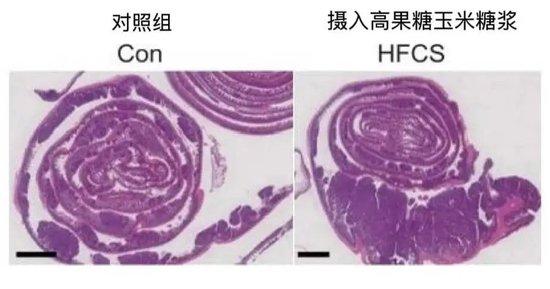
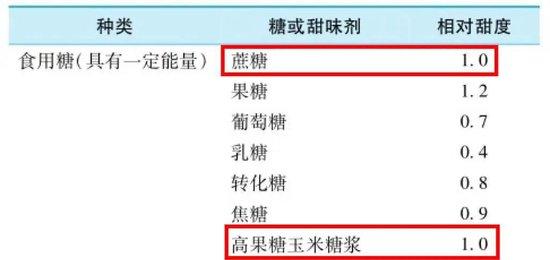
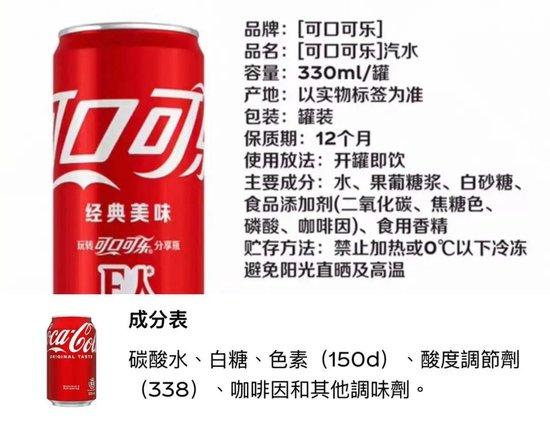
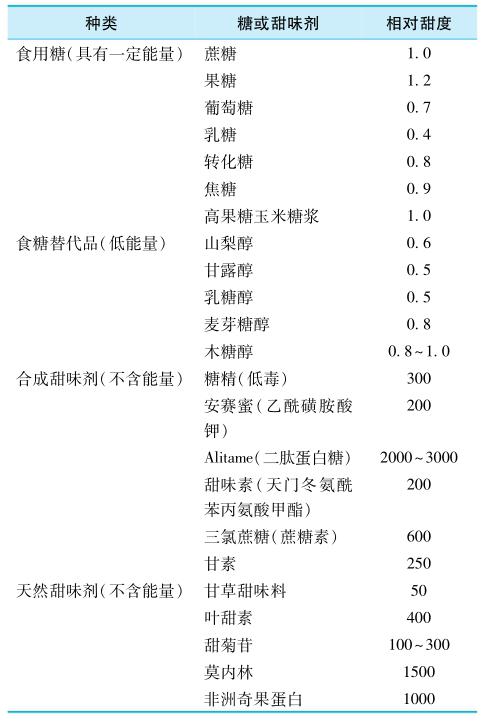
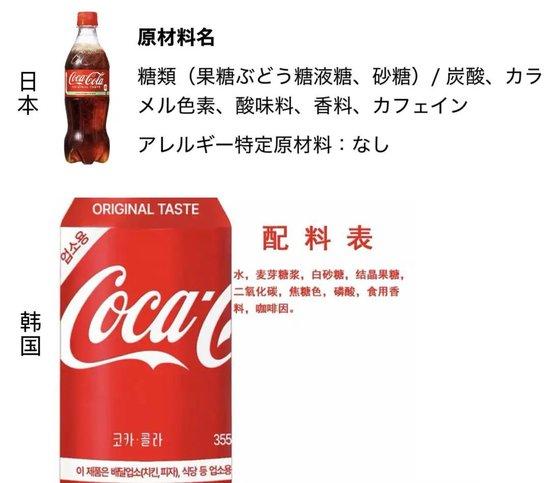

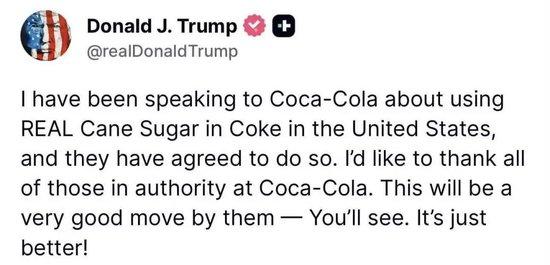
Coca-Cola is about to change its recipe?
Previously, Trump expressed on his social media platform that Coca-Cola had agreed to use real cane sugar in the production of its colas in the United States. “I want to thank all the top executives at Coca-Cola for this very right move—you will see it’s better this way!”
Source: X (Twitter) screenshot
At that time, Coca-Cola responded by stating that they did not commit to making changes and also mentioned in a statement, “We appreciate President Trump’s enthusiasm for our iconic brand, Coca-Cola. We will share more details soon about innovative products within our Coca-Cola product line.”
On July 22, Coca-Cola released its financial report for the second quarter of 2025. In the report, Coca-Cola announced plans to launch a product using American cane sugar in the fall of this year to expand its Coca-Cola trademark product line.
According to public media reports, Coca-Cola currently uses corn syrup in the United States, while in markets like Mexico and Europe, it uses cane sugar. It remains unclear whether the company plans to modify the original formula of Coca-Cola in the US or introduce new products.
On July 17, U.S. time, PepsiCo stated that if consumers have a demand, their beverage products will also use cane sugar.
Is the formula of Coca-Cola really different around the world? What’s the difference between adding corn syrup to Coca-Cola and using cane sugar?
Are there many different formulas for Coca-Cola?
To conclude: The formula of Coca-Cola indeed has multiple versions, taking classic flavors as an example, the formula varies slightly from one country to another.
Let’s start with North America. The ingredients of American and Canadian Coca-Colas are mostly the same, containing carbonated water, caramel coloring, phosphoric acid, natural flavorings, and caffeine. The only difference is the sugar. In the United States, it is high fructose corn syrup, while in Canada, it is cane sugar/glucose fructose.
Located in Latin America, the formula for Mexican Coke consists of carbonated water, white sugar (sucrose), caramel coloring, phosphoric acid, flavorings, and caffeine.
Source: Tmall Global Super Store
Turning our attention to Europe, the formula for Coca-Cola in the UK, France, and Germany is essentially consistent, with the UK and France listing carbonated water as a component, while Germany splits it into water and carbon dioxide, essentially identical to carbonated water. Other ingredients include sucrose, caramel coloring, phosphoric acid, natural flavors, and caffeine.
In Asia, Japanese Coca-Cola contains fructose glucose syrup (fructose syrup), white sugar, carbonated water, caramel coloring, sour agents, flavorings, and caffeine. The Korean version sold on e-commerce platforms contains maltose syrup, white sugar, crystalline fructose, three types of sugars, and other ingredients are regular water, carbon dioxide, caramel coloring, phosphoric acid, flavorings, and caffeine.
Source: Coca-Cola official website; Taobao Happy Xixi Lifestyle Store
In mainland China, the main components of Coca-Cola are water, fructose syrup, white sugar, food additives (carbon dioxide, caramel coloring, phosphoric acid, caffeine), flavorings. In Hong Kong, China, the formula includes carbonated water, white sugar, caramel coloring, acidity regulator, caffeine, and other seasonings.
Source: Taobao Coca-Cola flagship store; Coca-Cola official website
It’s worth mentioning that although the main ingredients of Coca-Cola are public knowledge, the core technology “7X” has never been disclosed. A book titled “I Am Me: Coca-Cola” published by Renmin University of China Press in 2016 mentioned that “7X” consists of three key ingredients, each controlled by one of the company’s senior executives. To prevent accidental loss of the secret recipe, the three individuals were not even allowed to travel together using the same means of transportation.
Overall, the biggest difference in the ingredients of Coca-Cola across different regions lies in the sugar content.
Currently, the sweeteners used by Coca-Cola primarily include high fructose corn syrup, sucrose (white sugar), fruit juice concentrate, malt syrup, and crystalline fructose.
Why do different countries and regions use different types of sugar in their Coca-Colas?
Liu Shaowei, a director of the Shanghai Food Safety Research Association, told Yiduo that this is mainly due to cost issues.
“This includes the sources of raw materials, costs, and cost-effectiveness. The United States has a larger area of corn cultivation, so compared to it, the American version of Coca-Cola uses the lower-cost high fructose corn syrup instead of sucrose. Moreover, as long as the final flavor consistency or basic consistency of the beverage is ensured, and it meets local standards, there is no mandatory requirement for using certain ingredients,” Liu said.
So, is the sugar always high fructose corn syrup in American versions of Coca-Cola?
The sweeteners in American Coca-Cola
A lesser-known fact: Coca-Cola initially did not use corn syrup but sucrose.
In 1886, a pharmacist named John Pemberton from Atlanta, Georgia, USA, added various ingredients into a triangular pot to create a caramel-colored liquid. After adding soda water, he produced the world-famous carbonated drink: Coca-Cola.
Pemberton | Image source: Reference [3]
Initially developing this beverage, Pemberton added nearly 12 kinds of spices including fruit extracts and essential oils. With spices, it was also necessary to pair them with a large amount of sugar. It’s worth mentioning that Pemberton chose only sucrose from the beginning.
At the time, Pemberton specified in the recipe that each gallon of Coca-Cola required more than 5 pounds of sucrose.
The reason why Coca-Cola chose sucrose is mainly because it is abundant and inexpensive. Data from “The Coca-Cola Empire” by Barto J. Elmore illustrates this point.
In the 1890s, the supply of sugar in the American market was unprecedentedly abundant and affordable, with prices as low as 4 cents per pound. In 1895 alone, Coca-Cola Company purchased over 380,000 pounds of sugar from Boston’s Rivel Sugar Company in Massachusetts.
Around 1915, Coca-Cola had become the world’s largest buyer of sugar. Over the next 60 years, sugar prices fluctuated, but Coca-Cola managed to survive the price wars by consistently using the same sweeteners. It wasn’t until the 1970s that sugar prices experienced a rollercoaster ride, prompting Coca-Cola to seek alternatives to sugar.
A new sweetener appeared on Coca-Cola’s radar: high fructose corn syrup. The company used an enzyme called isomaltase to convert glucose molecules extracted from corn starch into sweeter fructose molecules, then produced a new concentrated syrup—high fructose corn syrup.
In 1974, Coca-Cola conducted a trial substitution experiment. Instead of directly risking its brand, the company first altered the formulas of non-cola beverages (including Sprite, Mr. Pabst, and Fanta) to increase the use of high fructose corn syrup to 25%. A year later, Coca-Cola began adding 50% high fructose corn syrup to its cola; by 1985, the content of high fructose corn syrup in all Coca-Cola and non-cola beverages in the United States had reached 100%.
After the substitution, consumer feedback was positive without strong opposition to the change. Additionally, corn prices were cheaper than sugar at the time, with the price of high fructose corn syrup being 10% to 15% lower than sugar for some corn refineries. Thus, high fructose corn syrup officially entered Coca-Cola’s production line, marking the end of the era where Coca-Cola products used sugar.
So, excluding the cost factor, what’s the difference between sucrose and high fructose corn syrup?
What’s the difference between different sugars?
Internationally, sweeteners are generally categorized into three types. One category includes edible sugars such as sucrose and dextrose; another category consists of substitutes for edible sugars like sugar alcohols; and the third category comprises high-strength sweeteners like saccharin, aspartame, and acesulfame. The chemical structures, sweetness levels, and application scenarios of these sugars differ significantly. For instance, in terms of sweetness, fructose is the most sweet, followed by sucrose, caramelized sugar, maltose, glucose, and lactose.
Image source: Reference [4]
Now, specifically focusing on the main characters of this event—sucrose and high fructose corn syrup—what are their differences?
Let’s start with sucrose. Sucrose is the most common sweetener extracted from sugarcane or sugar beets, formed by condensing one glucose molecule and one fructose molecule together. Common table sugars such as granulated sugar, brown sugar, and molasses are all sucrose.
Chemical structure of sucrose | Image source: Reference [4]
High fructose corn syrup contains glucose, maltose, high-fructose syrup, and amylase, also known as starch syrup. In its production, first, the starch in corn is broken down into glucose through amylases, then some of the glucose is converted to fructose using another enzyme.
Generally speaking, high fructose corn syrup typically consists of 55% fructose and 45% glucose. This is because the fructose content exceeds that of glucose, giving this syrup its name “high fructose.”
In terms of sweetness, there isn’t much difference between sucrose and high fructose corn syrup; they both have a sweetness level of 1.0.
Source: Reference [4]
However, according to a report by China News Network, some food scientists have indicated that there are subtle differences in flavor between these two sweeteners. High fructose corn syrup has a sweeter peak earlier, which helps enhance the flavors of fruits and spices. Sucrose, on the other hand, has a broader sweetness and a longer duration.
Given that the sweetness and taste are not significantly different between the two sugars, is there a difference from a health perspective?
Studies have shown that both sucrose and high fructose corn syrup can pose certain risks to human health. A study published in the Journal of Clinical Endocrinology and Metabolism in 2021 by the University of California, Davis, suggests that sucrose may be as harmful as high fructose corn syrup.
The study found that both high fructose corn syrup and sucrose affect liver fat, insulin sensitivity, blood lipids, lipoproteins, and uric acid levels. Specifically, both sweeteners increase liver fat, blood lipids, lipoproteins, and uric acid content while reducing insulin sensitivity. However, the effects produced by high fructose corn syrup and sucrose were not significantly different. In terms of increasing the risk of heart metabolic diseases, the effects of the two sugars were comparable.
A study led by the Baylor College of Medicine and Weill Cornell Medicine in 2019 directly pointed out the negative impact of high fructose corn syrup. The research team used a mouse model for colon cancer to test the changes in tumors after consuming high fructose corn syrup. They found that tumors could effectively absorb fructose and glucose through various pathways, even with minimal intake of high fructose corn syrup, it still promoted tumor growth.
Comparison of tumor size in mice without and with high fructose corn syrup consumption | Source: Reference [6]
In any case, no matter which type of sugar is consumed in excess, controlling the amount of sugar intake is undoubtedly the right approach.
The “Dietary Guidelines for Chinese Residents (2022)” recommend that the daily intake of added sugars for adults should not exceed 50g, with a preference to keep it below 25g.
So whether American versions of Coca-Cola change their formula or not, the amount of sugar will remain the same. As for which sweetener is better, let the taste buds decide.
[1] Barto J. Elmore. The Empire of Coca-Cola: A History of Resource Destruction [M]. Shanghai People’s Publishing House, 2018.
[2] Tom Strandich. God’s Drink: The Story of Six Bottles [M]. CITIC Publishing Group, 2017.
[3] Peng Jianfeng, Tong Rugen, Ma Huiying. I Am Coca-Cola: Coca-Cola [M]. Renmin University of China Press, 2016.
[4] Yang Yuexin, Ge Keyou. Comprehensive Encyclopedia of Chinese Nutrition [M]. People’s Health Publishing House, 2019.
[5] The Paper News: Trump Wants Coca-Cola to Change Its Formula, and So It Did
[6] Dwsiree M.Sigala, et al. Consuming Sucrose-or HFCS-sweetened Beverages Increases Hepatic Lipid and Decreases Insulin Sensitivity in Adults [J]. The Journal of Clinical Endocrinology & Metabolism, 2021, Vol.106, No.11, 3248-3264.
[6] Marcus D. Goncalves, et al.
High-fructose corn syrup enhances intestinal tumor growth in mice[J]. Science, 2019, Vol.363, Issue 6433, 1345-1349.